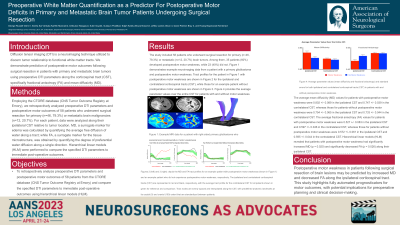Preoperative White Matter Quantification as a Predictor for Postoperative Motor Deficits in Primary and Metastatic Brain Tumor Patients Undergoing Surgical Resection
Friday, April 21, 2023


Sneha Sai Mannam, BS (he/him/his)
Medical Student
Perelman School of Medicine at the University of Pennsylvania
Philadelphia, Pennsylvania, United States
ePoster Presenter(s)
Introduction: Diffusion tensor imaging (DTI) is a neuroimaging technique utilized to discern tumor relationship to functional white matter tracts. We demonstrate prediction of postoperative motor outcomes following surgical resection in patients with primary and metastatic brain tumors using preoperative DTI parameters along the corticospinal tract (CST), specifically fractional anisotropy (FA) and mean diffusivity (MD).
Methods: Employing the CTORE database (CNS Tumor Outcome Registry at Emory), we retrospectively analyzed preoperative DTI parameters and postoperative motor outcomes of 58 patients who underwent surgical resection for primary (n=46, 79.3%) or metastatic brain malignancies (n=12, 20.7%). For each patient, data were analyzed along their ipsilateral CST relative to tumor location. MD, a surrogate marker for edema was calculated by quantifying the average free diffusion of water along a tract; while FA, a surrogate marker for the tissue microstructure, was obtained by quantifying the degree of preferential water diffusion along a single direction. Hierarchical linear models (HLM) were performed to compare the specified DTI parameters to immediate post-operative outcomes.
Results: We found that patients with pathologically involved corticospinal tracts, as measured from preoperative DTI imaging, had significantly increased mean diffusivity (p = 0.020) and decreased fractional anisotropy (p=0.026) and presence of worsened post-operative motor deficits from baseline.
Conclusion : We demonstrate the possible predictive value of quantitative metrics of DTI, specifically FA and MD, for postoperative motor outcomes in brain tumors patients. This work demonstrates their utility as possible prognosticators of motor outcomes and reliable corollaries for preoperative planning.
Methods: Employing the CTORE database (CNS Tumor Outcome Registry at Emory), we retrospectively analyzed preoperative DTI parameters and postoperative motor outcomes of 58 patients who underwent surgical resection for primary (n=46, 79.3%) or metastatic brain malignancies (n=12, 20.7%). For each patient, data were analyzed along their ipsilateral CST relative to tumor location. MD, a surrogate marker for edema was calculated by quantifying the average free diffusion of water along a tract; while FA, a surrogate marker for the tissue microstructure, was obtained by quantifying the degree of preferential water diffusion along a single direction. Hierarchical linear models (HLM) were performed to compare the specified DTI parameters to immediate post-operative outcomes.
Results: We found that patients with pathologically involved corticospinal tracts, as measured from preoperative DTI imaging, had significantly increased mean diffusivity (p = 0.020) and decreased fractional anisotropy (p=0.026) and presence of worsened post-operative motor deficits from baseline.
Conclusion : We demonstrate the possible predictive value of quantitative metrics of DTI, specifically FA and MD, for postoperative motor outcomes in brain tumors patients. This work demonstrates their utility as possible prognosticators of motor outcomes and reliable corollaries for preoperative planning.
